Juror: Richard Hunt
Curator: Hank T. Foreman
Curator’s statement
For nine years I have had the privilege of working with the Rosen Outdoor Sculpture Competition and Exhibition. It is hard to believe, but that means during my tenure here I have seen 90 public sculptures go up as part of this exciting program. To date there have been 150 exhibited, and the permanent collection is growing to complement this annual exhibition. Thousands of people have participated in guided tours and lectures, and many more have experienced the artworks as they go about their everyday lives.
As I think about my years with the Rosen program, the first thing that comes to mind is the way this program has brought art into the lives of the community. I remember the people who were moved by a particular work. I remember the people who were intrigued by the mechanical ingenuity exhibited by a particular work. I remember the people who struggled to meet the challenge of new or thematically tough work. I remember the winter when Rosen Award Winner R.F. Buckley’s forged aluminum bed mysteriously became inhabited by a dapper set of snow people. I remember the smiles of pedestrians as they watched a vacant area filled with a new sculpture. I remember the crowd forming when Charles, “the crane guy,” took a sculpture up a little higher than required for dramatic effect. These memories, and the hundreds more, combine to reinforce my understanding of how this program has made a difference in the artistic life of the campus and community.
The opportunity to see new works, investigate their meaning and design, and the ability to re-experience them over the period of a year is an important aspect of this program. Unlike many exhibited works, these pieces become part of our lives for a year. This is the power and vitality of public art. However, this power comes at a price.
Public art … or for our purposes, outdoor sculpture … is often a risky proposition. Art displayed in a gallery is usually viewed by people whose express purpose is to look at art. While the viewer might not connect with certain works, they are in the frame of mind to see what art is displayed. Outdoor works occupy the same “real” time and space as we do every day. The artist or gallery – outside of providing catalogues, signs, and tours – for the most part does not have the opportunity to place works within a context or to even ensure that viewers are prepared to view art. This is the first risk … that certain members of the public won’t adjust their everyday mindset to properly consider the works.
The next risk is the flip side of a positive aspect. When art works are placed in the public realm the public often feels ownership of the works. Positively, this means that the works will be more accessible – not only physically but conceptually. Negatively, this means that the possibility exists for viewers to overstep their bounds. This happens when the public fails to acknowledge that art works are created by an artist, and, in addition to it’s designed communicative worth, they are their worthwhile property. These works are the fruits of the artist’s lives, and sharing them in such a public way is a very daring act.
Finally, placing works in the public domain can open artists and galleries up to severe scrutiny. Each have to be aware of this possibility and be prepared to deal with the situation in a way that respects the public concern and the integrity of their work. If handled correctly, this dialogue can make the program more meaningful for everyone concerned.
In closing, I offer my sincere admiration to the artists, this university, and Martin and Doris Rosen for meeting the challenges of public art. It must also be noted, that a huge amount of admiration must be bestowed upon the public for their participation in the exhibition of these 150 outdoor works. The rare instances when members of the public failed to live up to the challenge before them are far outweighed by their positive participation in this program.
Hank T. Foreman
Director & Chief Curator
Turchin Center for the Visual Arts
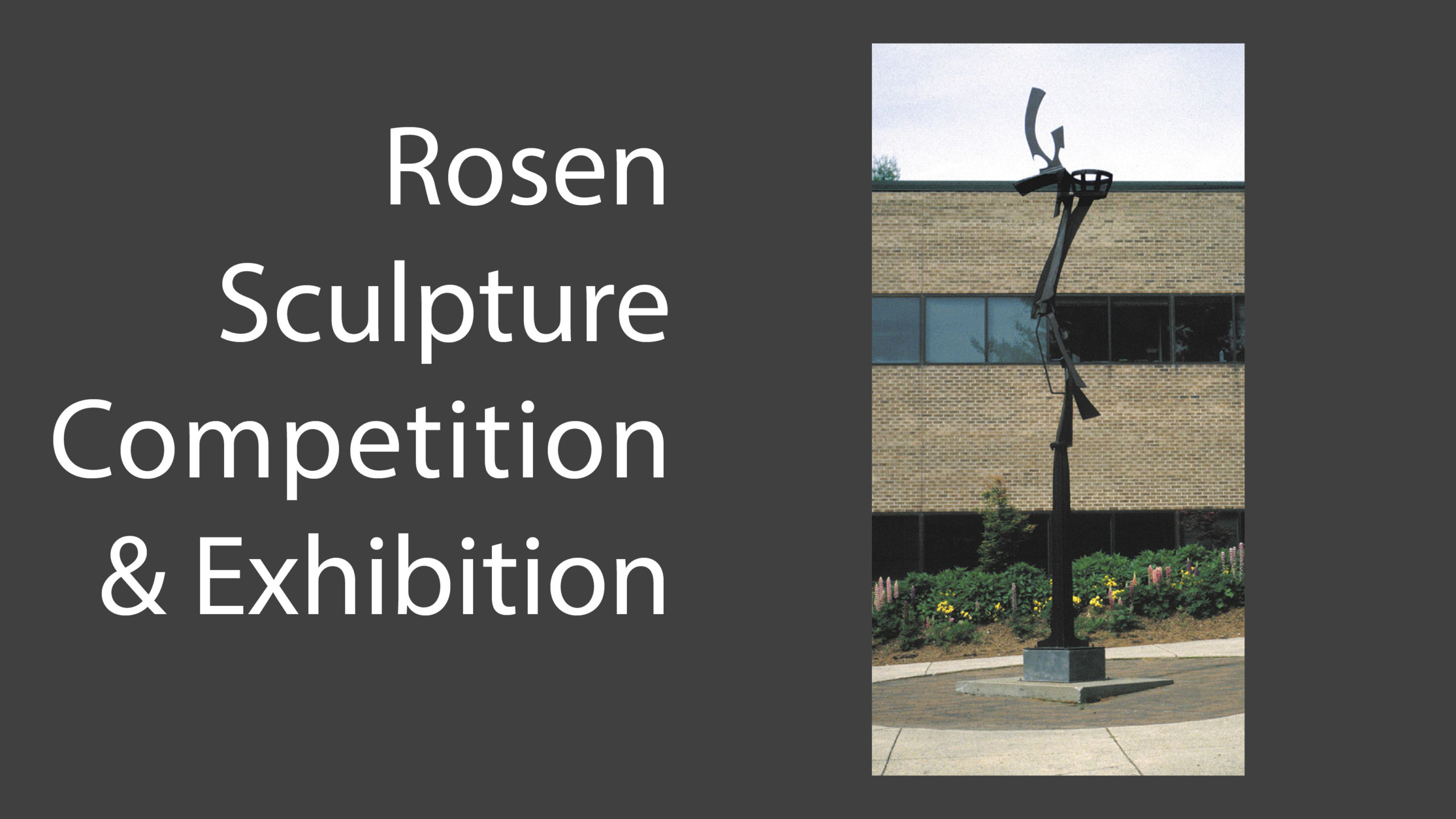
Dennis Peacock, Prometheus (still stealing fire). 2001 / 15th Rosen Sculpture Competition Winner.
Sculptures
-
Prometheus (still stealing fire)1st Place
Prometheus (still stealing fire)
Dennis Peacock
Knoxville, Tennessee
Steel
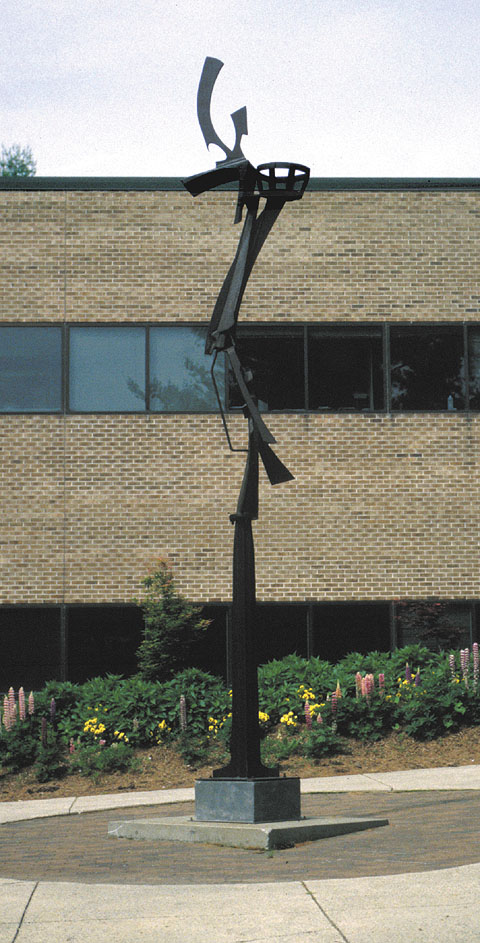
Artist statement
In the beginning of my career in sculpture, form was language enough, and the evocative possibilities of the way things went together were more than adequate. The nature of the material and the way that it responded to tools – hand and eye, could provoke a cycle of inquiry, could provide keys, clues, and questions. Abstraction, possibly derived from music, was supplemented by a consistent confidence in those universals found by an improvised and unplanned response to the materials. The work, as it developed, was responsible for its own content with the artist serving as the channel.
Recently, added dimensions and references include archetypal forms and symbols. Poetry, subject to my own interpretation and context, can work as an initial catalyst. The work is cast or constructed in steel, concrete, stainless, bronze, or iron. Form becomes a language that includes the narrative and the symbolic. The sculpture becomes visual metaphor with roots in the recognizable and the accepted. What we think we know becomes a bridge to the unfamiliar, a way to address the larger questions with minimal interference from our preconceptions.
Cash Crop
Severn Eaton
Brooklyn, New York
Mixed media
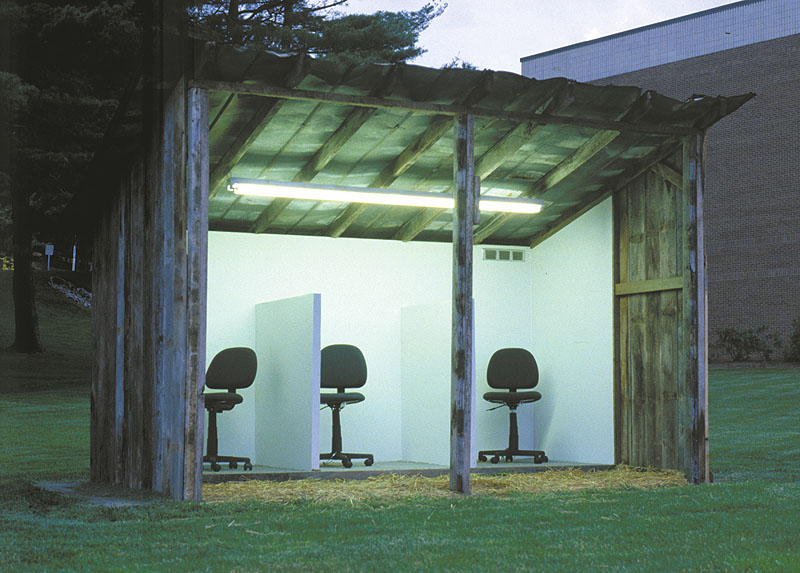
Artist statement
My recent work is concerned with how and why people have developed their surroundings throughout history. It looks at a past much more in balance with natural systems while questioning the current shift towards an increasingly synthetic living environment. “Cash Crop” is an attempt to examine these issues in a way that is pertinent to Appalachia. During my years living in the area, I was always struck by how beautifully old barns and sheds settle and decay back into the landscape. Then I would step into a fluorescent-lit vinyl, steel, and drywall office building and wonder how gracefully it will fall when its time comes. It amazed me to realize how we are consciously making this move towards completely artificial surroundings. By juxtaposing the old with the new, the natural with the synthetic, I hope to make this striking contrast as blatantly clear to all as possible, perhaps provoking a closer examination of how we create the spaces in which we live. The presence of the age-old metaphor of humans as livestock is a bit of an accident, but is inevitable when installing cubicles in a shed, and it works with the concept. Whatever level at which my work is perceived, I hope the audience is able to apply its meaning to their lives in some form.
Special thanks to everyone who helped in the creation of “Cash Crop.”
Dream Deferred
Robert Spinazzola
Hastings on Hudson, New York
Steel
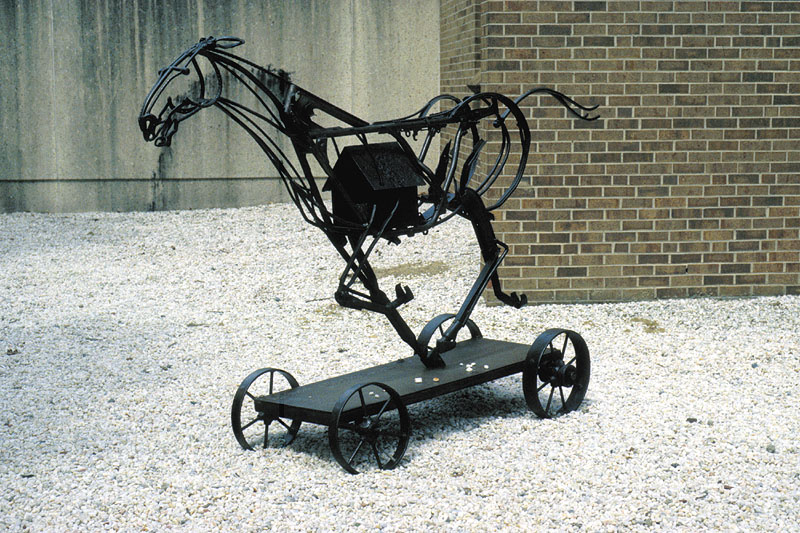
Artist statement
My sculptures are three dimensional steel drawings. When I began to make sculpture in 1975, I created the first works from discarded and salvaged steel. I find that used steel acquires a patina that makes it very interesting. Twenty six years later, I continue to employ this technique.
Out of reverence for my personal connection to nature, much of my work describes animal forms: birds, horses, tigers, and rabbits. Man has made visual representations of animal forms since the beginning of human culture, as exemplified by cave drawings. This is the intellectual link where my work begins: our earliest and closest physical bond, the beauty and mystery of Mother Nature.
In my pieces, my objective is to create an emotional attachment between the viewer and these steel objects through the suggestion of motion. If I can project some of nature’s qualities and cause the viewer to suspend the fact that they are seeing steel objects welded together, then I have succeeded in my work.
“Dream Deferred” was inspired by my reaction to the shifting gallery experience in NYC, Greek mythology, and a wonderful poem by Langston Hughes.
Emergent force
Robert Pulley
Columbus, Indiana
Stoneware clay
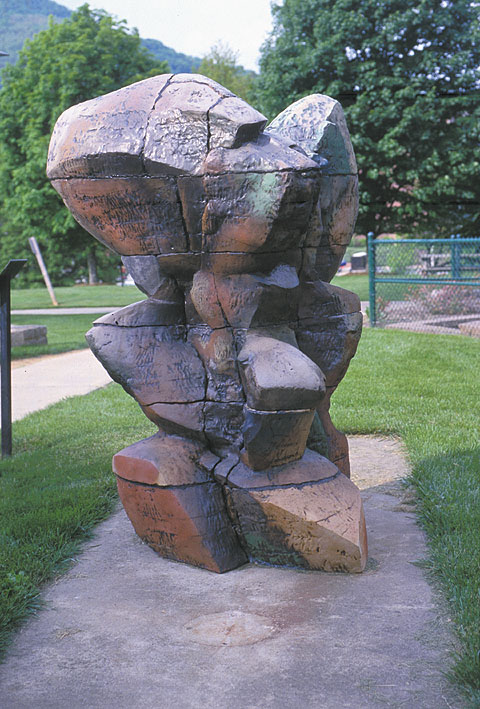
Artist statement
I have always sought a sense of energy and power in my sculpture. The forces of nature reveal themselves in forms resulting from the interaction of complex biological and physical laws. Cellular hydraulics, gravity, tropisms, inter-organism interactions, etc. yield common patterns of growth and proportion whose rightness we recognize as beautiful. It is this sense of natural power made visible that I seek to understand and reflect in my work.
Within my work there is always the reference to the human body and its gestures. The layering of references to the human figure with other natural forms is in accord with my sense of humanity as a part of nature and of the sacred web of existence.
Feminea Vitalitas
Dora Natella
South Bend, Indiana
Polyester resin and steel
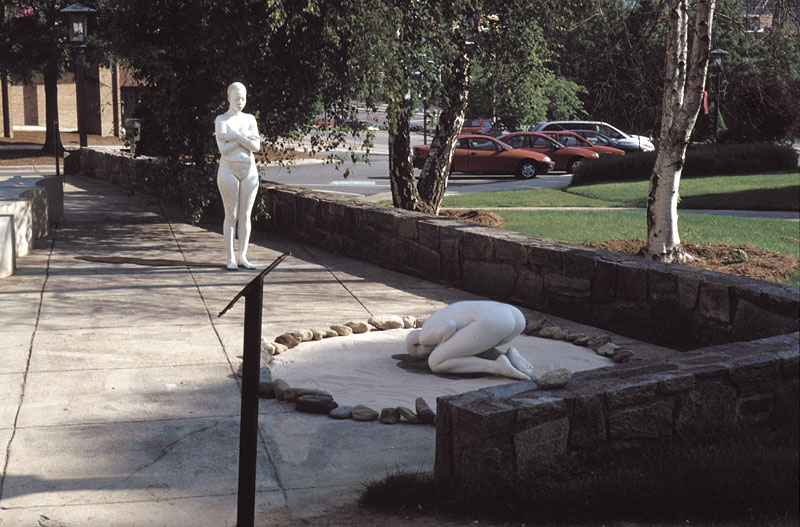
Artist statement
I was born in Venezuela to a family of immigrant Italians but was mostly raised and educated in Italy. At the age of twenty-one I moved to the United States.
Having more than one place I call home has given me a broad perspective about people, their cultures, and their experiences. Having artistic roots in both Ancient Europe and the New World has also been a key to my identity as an artist, as I have approached a contemporary style of sculpture from a classical background.
I moved to the United States in 1980 for advanced studies in bronze casting techniques and to expose myself to a totally new culture, one less inhibited by the authority of history. I earned my MFA in sculpture at Western Michigan University in 1986; and have taught sculpture, life drawing, two- and three-dimensional Design there for six years. In 1992 I was hired as the Sculpture Area Coordinator at Indiana University in Bloomington, Indiana. At that time my research and creative work gradually became centered on the female figure. My sculptural installations sparked interest in their statement and cross-cultural references to Latino women’s experiences and generated topical dialogue of universal women’s issues.
My most recent work has addressed fundamental aspects of my own life experiences as a woman. Themes such as motherhood, death and mourning, and the celebration and renewal of life through the menses have become my predominant directions.
Since 1995 I lived in Eugene, Oregon where I taught sculpture at the University of Oregon for four years while developing my own creative research and teaching private classes and seminars. In addition, I have exhibited frequently and won numerous grants and awards including a lecturing/research Fulbright Award given by the U.S. Information Agency and more recently the Alex J. Ettl Grant given by the National Sculpture Society in New York City.
Last year, I exhibited a ten feet tall bronze, titled “Gala,” in Pier Walk 2000, the world’s largest international outdoor sculpture exhibition, set on Chicago’s historic Navy Pier. Currently, I am busy creating a new bronze sculpture for Pier Walk 2001 exhibit.
Keepsake
Scott Wallace
Hendrix, Minnesota
Bronze
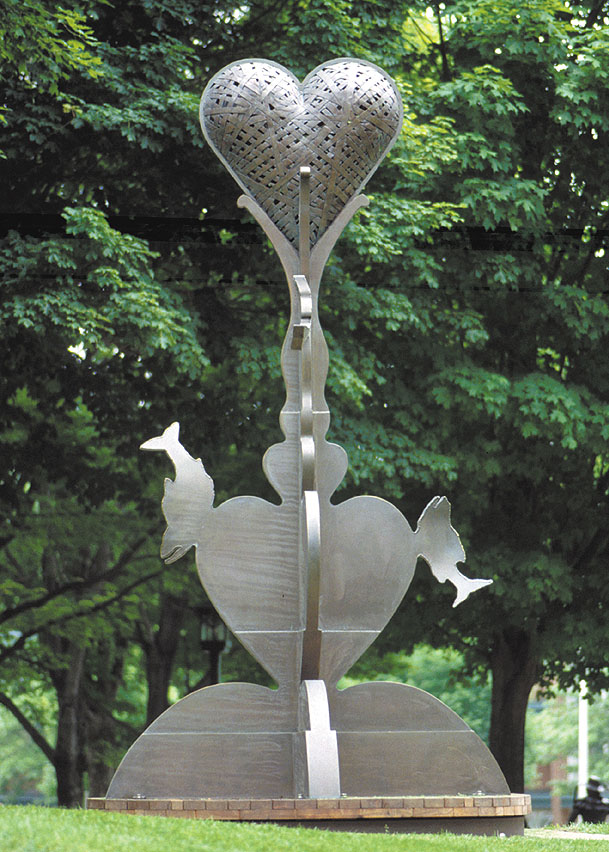
Artist statement
“Keepsake” is an amalgam of forms inspired by the shapes, ornamental qualities, and the symbolic wealth of treasured objects.
Learn to Swim
Brett Hunter
Nashville, Tennessee
Steel and granite

Artist statement
In a general sense my work is based on the assumption that everyone’s identity – mine in particular – is divided into an internal self and an external self. The internal self is the constant unconscious basis of who we are. It is the realm of emotion and reaction, the psychological substructure that we rely on in moments of introspection, necessity, or trauma. The other side of this division, the external self, is the outward persona that we present to the world around us, a conscious construction of who we want to be, the continuously fluctuating state of action and appearance. As one goes through life there is a constant conversation between one’s internal thoughts and aspirations and the external persona that is presented to others. No matter how well constructed our external selves are, no matter how strong the walls we build around ourselves, the internal core becomes visible, through familiarity, crisis, or investigation. Through the use of three dimensional concepts and compositions I come to terms with components of “self” that I do not fully understand, and introspectively explore emotions, philosophical dilemmas, sociopolitical concepts, and the ways in which I affect and am affected by these issues.
More specifically, the work in this exhibition focuses on the issues involved in encountering new places or experiences. When immersed in a place and surrounded by people which are completely new and different, we experience a sense of isolation and must rely on both our conscious knowledge of ourselves and our surroundings, as well as fall back on the subconscious basis of who we are. In new situations we must adapt and train ourselves (often despite the barriers of past experience) to fit this new experience, or risk missing the opportunity for growth. “Learn to Swim” deals with these ideas by relating these psychological issues to the physical one of being thrown into water for the first time. As with new experiences, when submersed in water we can surrender and sink to the bottom or retrain ourselves (albeit with a certain amount of flailing about) to adjust to our new surroundings. We must reformat our bodies to paddle and float just as we must adjust our minds to accept new experiences.
Mass
Ann Melanie
Greenville, North Carolina
Welded painted steel
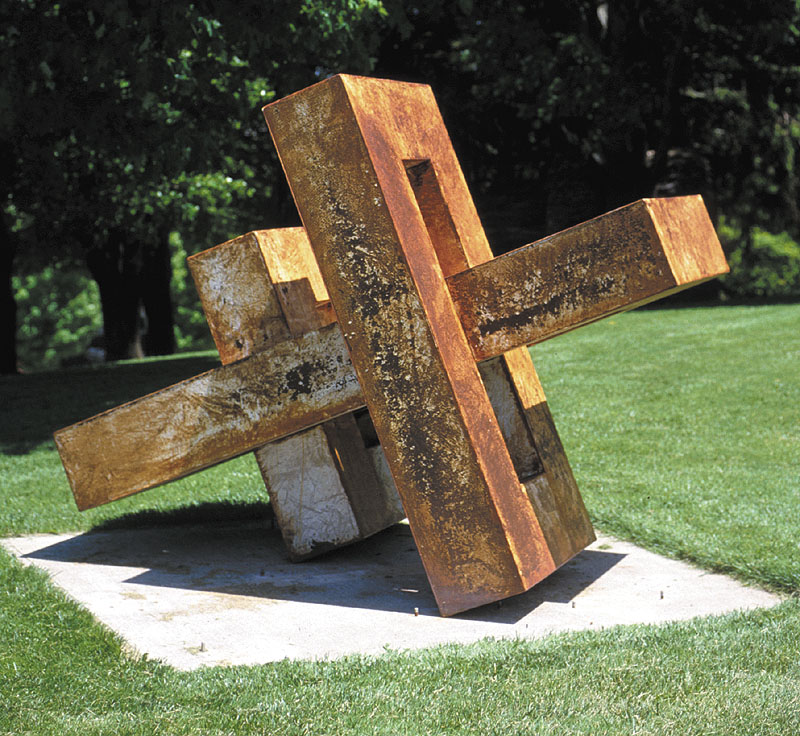
Artist statement
My work represents my explorations in methods, materials, and scale. The work is structural in nature drawing from constructivism, minimalism, and my affinity for straight lines and right angles; it encompasses a wide variety of media and process, ranging in scale from miniatures to monumental. I choose simple geometric shapes as my basis of my work, this allows me great latitude in the creation of my sculpture.
These simple forms lend themselves readily to casting, carving, fabrication, and construction; it also allows me unlimited oportunity to explore surface. The use of simple shape establishes a level of recognition for the viewer. The repetition of same or similar elements strengthens the viewers sense of the familiar. The rectilinear forms represent windows and door; windows which look from my world into yours but keep us apart, and doors which allow us passage through. Windows and doors are not literal images, but act as a symbolic reference to ideas, images, and emotions. My work is the sum of my life experiences it has no specific meaning and it means everything. The work is simple in its form and complex in its construction.
About the artist
Ann Melanie, was born in Moses Lake Washington, her family is from Skowhegan Maine; Melanie received her MFA in sculpture in 1995 from East Carolina University. Her work includes gallery-scale and large public sculptures. Melanie uses simple forms that lend themselves to casting, carving and fabrication. She has shown throughout the United States in many venues, including the Rosen Outdoor Sculpture Competition, and The Pyramid Sculpture Park in Hamilton, Ohio. Her work is part of the permanent collection of the East Carolina Sculpture Park. She currently lives in Greenville, North Carolina where she is the academic advisor for the School of Art and Design at East Carolina University.
Texas Two-Step
Robbie Barber
Waco, Texas
Steel, paint and found objects
11′ x 7′ x 12′

Artist statement
The work I have been doing the past several years deals with the vernacular architecture of the American landscape. It is a landscape filled with working class habitats, abundant with a strong visual character and a sense of history. Although nostalgic and quaint on one level, these works often evoke a feeling of sadness, reflecting the inevitable social and economic changes that occur in our lives. I am reminded of the stories my Aunt Mildred used to tell me of her life in rural North Carolina, and of the ones she wouldn’t tell me, no matter how much I prodded. It brings to mind the cliche, “if these walls could speak.”
Specifically, “Texas Two-Step” is an homage to the roadside monuments of the Southwest United States. It represents a collage of various architectural elements that dot this geographical region. Having hauled art throughout this endless expanse, I have grown to appreciate the cotton gins, water towers, and Dairy Queens that in many ways define this area.
About the artist
Robbie Barber is currently Associate Professor of Art at Baylor University in Waco, Texas. Born in Williamston, North Carolina in 1964, he was raised on a farm near the Roanoke River in Martin County. He received his BFA degree from East Carolina University in 1987 and his MFA degree from the University of Arizona in 1991. He has gained notoriety as a sculptor working in a variety of media, and is the recipient of numerous awards. These include a North Carolina Arts Council Fellowship and a Southern Arts Federation/NEA Fellowship in Sculpture. He has exhibited at the Grace Museum in Abilene, Texas, Socrates Sculpture Park in Long Island City, New York, the Roswell Museum and Art Center in Roswell, New Mexico, the Rocky Mount Art Center in Rocky Mount, North Carolina, and Grounds For Sculpture in Hamilton, New Jersey, to name a few.
For more information, visit robbiebarber.com.
Totemic XX
Glenn Phifer
Boone, North Carolina
Welded aluminum and copper sheets
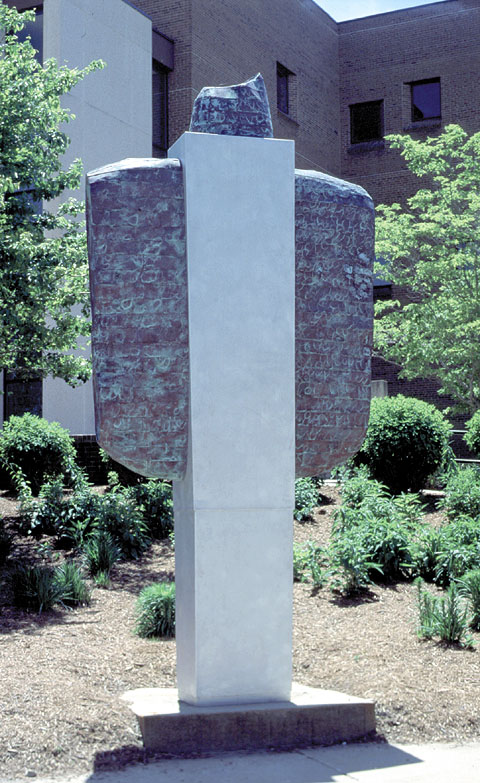
Artist statement
The “Totemic Series” comprise a body of large, outdoor works. Using the totem-like structure, I work with combining dissimilar materials, ie. steel with stone, wood with metal, and copper with aluminum. These give contrast in color as well as surface and texture. The challenge of combining these materials, allows me to explore the concept of an organic form penetrating a larger geometric shape. To me, the structure of our present society seems to want a melting of natural organic shapes which are becoming farther removed from everyday life with the refined geometric stable forms that are far more readily available to us.
About the juror
From the South side of Chicago and the deep depression of 1935, Richard Hunt has sculpted his way in to the canons of 20th century American Modern Art history. Today, the South side of Chicago continues to claim him, as the state of Illinois, the nation, and the international world of modern art proclaim him.
His career, which spans fifty years, has resulted in a prolific body of work which he refers to as his “drawings in space.” The physicality of his chosen medium is consistent with the industrial mid-west. He forsakes the genteel canvas for steel, anvils, and the welder’s flame. He “draws in space” with metals of aluminum, bronze, copper, and steel; cutting, hammering, burning, and sanding the metal, transforming crude materials into exquisite sculptures and majestic public art monuments.
Richard Hunt was appointed, by President Lyndon Johnson, to serve as one of the first artists on the governing board of the National Endowment for the Arts. He has continued to serve on the board of the quintessential art institutions in America and abroad; including the Board of Trustees for the Ravinia Festival, Museum of Contemporary Art, Chicago; American Academy in Rome; National Board of Directors, Smithsonian Institute; and the esteemed American Academy of Arts and Letters. His professorships and artist residencies include Yale University, Purdue University, Cornell University, and Harvard University.
Richard Hunt is a preeminent American sculptor at the apex of a prolific and successful career. His work includes gallery-scale sculptures displayed and collected by major museums, and over 100 large-scale public art commissions created for American cities, campuses, and corporations. This body of work is immediately recognizable by Hunt’s evocative forms which fuse the man-made with the natural, melding the gritty muscularity of America’s industrial-urban environment with Hunt’s passion for natural forms and biology. In source and in content they bridge European Modernism with the art of African blacksmiths and integrate ancient mythology with African-American literary and musical traditions. Potent from such broad and diverse sources, the sculptures resonate with multiple layers of meaning, giving voice to America’s unique hybridized cultural experience.
Hunt’s art is the product of transformation, improvisation, and regeneration firmly rooted in multiple histories and traditions, and always moving forward in positive ways.
B.E. Noel, President
Noel Gallery Fine Art Acquisitions, Inc.
July 2001
Richard Hunt is represented in the Southeast United States by Noel Gallery in Charlotte, North Carolina. They provided the images of of Mr. Hunt’s work shown on this page.
About the curator
Hank Foreman serves as Assistant Vice Chancellor of Arts and Cultural Affairs as well as Director and Chief Curator of the Turchin Center for the Visual Arts for Appalachian State University. He obtained his M.A. in Art Education from Appalachian, having completed undergraduate studies at the University of North Carolina at Charlotte, with a concentration in Painting and Sculpture. His duties include the administrative responsibilities for An Appalachian Summer Festival, the Performing Arts Series, Farthing Auditorium and the Turchin Center for the Visual Arts.
During his tenure at Appalachian State, Foreman has taken part in the organization of numerous exhibitions, including the associated lectures, symposia, and publications. He has worked closely with the university’s Department of Art, and a wide variety of other campus and community groups, to make gallery resources available to all. One of his earliest exhibitions at Appalachian, Views From Ground Level: Art and Ecology in the Late Nineties, brought internationally acclaimed artists, historians, and critics to the campus and received national attention.
Foreman is also an exhibiting studio artist, and participates in regional and national conferences as a presenter and panelist.
A Special Thanks from the Curator
On behalf of An Appalachian Summer Festival, the Office of Cultural Affairs, and the Catherine J. Smith Gallery, I wish to thank all of the artist who participated in this year’s competition and congratulate those chosen for the exhibition. Each year the Rosen Outdoor Sculpture Competition and Exhibition is made possible by the generous support of Martin and Doris Rosen. The Rosens are tireless supporters of the arts, and over the years have given so much of themselves to ensure that the arts became a more integral part of our community. Their excitement and dedication serve as both inspiration and role model. I would like to thank our juror, Richard Hunt, for his dedication and professionalism during the completion of his difficult task. I wish to thank my colleagues in the Office of Cultural Affairs, my colleagues in the Art Department, and the students who participated in the installations. Special thanks to our designer – Mike Fanizza, photographer – Christopher Bledsoe, Assistant to the Gallery Director – Brook Greene, the folks at Boone Crane, and our interns Heather Cadmus and Hillary Frye. A heartfelt thanks to Jim Bryan – Grounds Superintendent, and to Evan Rowe – Safety Officer. We also extend our thanks to the entire Grounds Department of the Appalachian State University Physical Plant. Their cooperation and expertise continues to make our campus a beautiful venue for outdoor sculpture. A special thank you goes out to Sonny Struss, Department of Art Studio Technician, for his expert assistance and his generous spirit.
– Hank T. Foreman
